Sheng Bi
OneEval: Benchmarking LLM Knowledge-intensive Reasoning over Diverse Knowledge Bases
Jun 14, 2025



Abstract:Large Language Models (LLMs) have demonstrated substantial progress on reasoning tasks involving unstructured text, yet their capabilities significantly deteriorate when reasoning requires integrating structured external knowledge such as knowledge graphs, code snippets, or formal logic. This limitation is partly due to the absence of benchmarks capable of systematically evaluating LLM performance across diverse structured knowledge modalities. To address this gap, we introduce \textbf{\textsc{OneEval}}, a comprehensive benchmark explicitly designed to assess the knowledge-intensive reasoning capabilities of LLMs across four structured knowledge modalities, unstructured text, knowledge graphs, code, and formal logic, and five critical domains (general knowledge, government, science, law, and programming). \textsc{OneEval} comprises 4,019 carefully curated instances and includes a challenging subset, \textsc{OneEval}\textsubscript{Hard}, consisting of 1,285 particularly difficult cases. Through extensive evaluation of 18 state-of-the-art open-source and proprietary LLMs, we establish three core findings: a) \emph{persistent limitations in structured reasoning}, with even the strongest model achieving only 32.2\% accuracy on \textsc{OneEval}\textsubscript{Hard}; b) \emph{performance consistently declines as the structural complexity of the knowledge base increases}, with accuracy dropping sharply from 53\% (textual reasoning) to 25\% (formal logic); and c) \emph{diminishing returns from extended reasoning chains}, highlighting the critical need for models to adapt reasoning depth appropriately to task complexity. We release the \textsc{OneEval} datasets, evaluation scripts, and baseline results publicly, accompanied by a leaderboard to facilitate ongoing advancements in structured knowledge reasoning.
Magic Mushroom: A Customizable Benchmark for Fine-grained Analysis of Retrieval Noise Erosion in RAG Systems
Jun 05, 2025Abstract:Retrieval-Augmented Generation (RAG) systems enhance Large Language Models (LLMs) by incorporating external retrieved information, mitigating issues such as hallucination and outdated knowledge. However, RAG systems are highly sensitive to retrieval noise prevalent in real-world scenarios. Existing benchmarks fail to emulate the complex and heterogeneous noise distributions encountered in real-world retrieval environments, undermining reliable robustness assessment. In this paper, we define four categories of retrieval noise based on linguistic properties and noise characteristics, aiming to reflect the heterogeneity of noise in real-world scenarios. Building on this, we introduce Magic Mushroom, a benchmark for replicating "magic mushroom" noise: contexts that appear relevant on the surface but covertly mislead RAG systems. Magic Mushroom comprises 7,468 single-hop and 3,925 multi-hop question-answer pairs. More importantly, Magic Mushroom enables researchers to flexibly configure combinations of retrieval noise according to specific research objectives or application scenarios, allowing for highly controlled evaluation setups. We evaluate LLM generators of varying parameter scales and classic RAG denoising strategies under diverse noise distributions to investigate their performance dynamics during progressive noise encroachment. Our analysis reveals that both generators and denoising strategies have significant room for improvement and exhibit extreme sensitivity to noise distributions. Magic Mushroom emerges as a promising tool for evaluating and advancing noise-robust RAG systems, accelerating their widespread deployment in real-world applications. The Magic Mushroom benchmark is available at https://drive.google.com/file/d/1aP5kyPuk4L-L_uoI6T9UhxuTyt8oMqjT/view?usp=sharing.
Seaweed-7B: Cost-Effective Training of Video Generation Foundation Model
Apr 11, 2025Abstract:This technical report presents a cost-efficient strategy for training a video generation foundation model. We present a mid-sized research model with approximately 7 billion parameters (7B) called Seaweed-7B trained from scratch using 665,000 H100 GPU hours. Despite being trained with moderate computational resources, Seaweed-7B demonstrates highly competitive performance compared to contemporary video generation models of much larger size. Design choices are especially crucial in a resource-constrained setting. This technical report highlights the key design decisions that enhance the performance of the medium-sized diffusion model. Empirically, we make two observations: (1) Seaweed-7B achieves performance comparable to, or even surpasses, larger models trained on substantially greater GPU resources, and (2) our model, which exhibits strong generalization ability, can be effectively adapted across a wide range of downstream applications either by lightweight fine-tuning or continue training. See the project page at https://seaweed.video/
From Superficial to Deep: Integrating External Knowledge for Follow-up Question Generation Using Knowledge Graph and LLM
Apr 08, 2025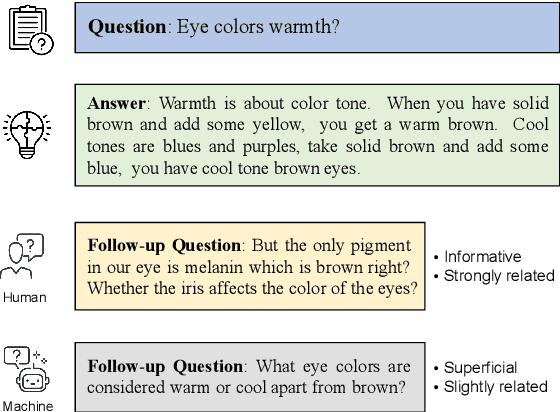

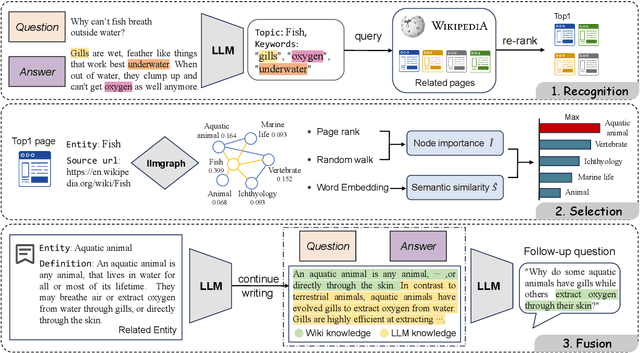

Abstract:In a conversational system, dynamically generating follow-up questions based on context can help users explore information and provide a better user experience. Humans are usually able to ask questions that involve some general life knowledge and demonstrate higher order cognitive skills. However, the questions generated by existing methods are often limited to shallow contextual questions that are uninspiring and have a large gap to the human level. In this paper, we propose a three-stage external knowledge-enhanced follow-up question generation method, which generates questions by identifying contextual topics, constructing a knowledge graph (KG) online, and finally combining these with a large language model to generate the final question. The model generates information-rich and exploratory follow-up questions by introducing external common sense knowledge and performing a knowledge fusion operation. Experiments show that compared to baseline models, our method generates questions that are more informative and closer to human questioning levels while maintaining contextual relevance.
PRIMO: Progressive Induction for Multi-hop Open Rule Generation
Nov 02, 2024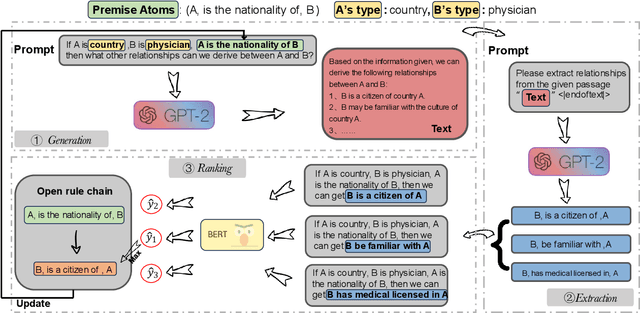
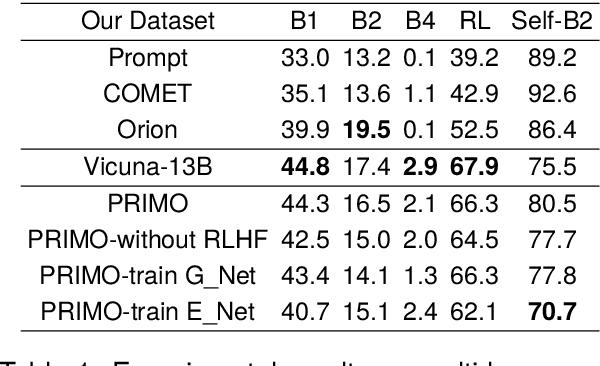
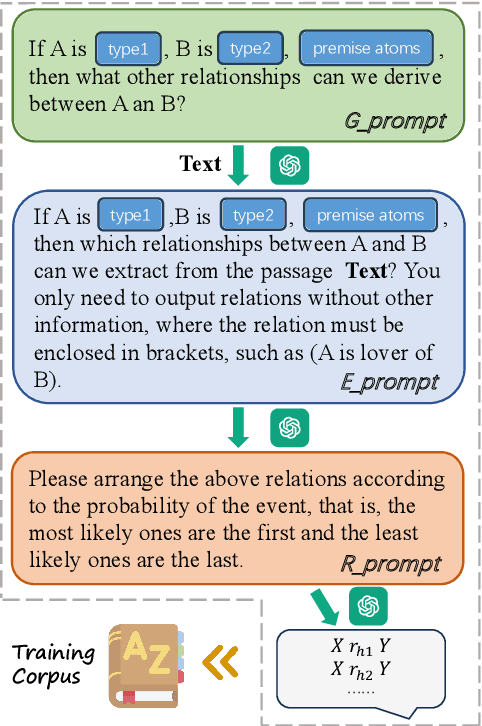

Abstract:Open rule refer to the implication from premise atoms to hypothesis atoms, which captures various relations between instances in the real world. Injecting open rule knowledge into the machine helps to improve the performance of downstream tasks such as dialogue and relation extraction. Existing approaches focus on single-hop open rule generation, ignoring multi-hop scenarios, leading to logical inconsistencies between premise and hypothesis atoms, as well as semantic duplication of generated rule atoms. To address these issues, we propose a progressive multi-stage open rule generation method called PRIMO. We introduce ontology information during the rule generation stage to reduce ambiguity and improve rule accuracy. PRIMO constructs a multi-stage structure consisting of generation, extraction, and ranking modules to fully leverage the latent knowledge within the language model across multiple dimensions. Furthermore, we employ reinforcement learning from human feedback to further optimize model, enhancing the model's understanding of commonsense knowledge. Experiments show that compared to baseline models, PRIMO significantly improves rule quality and diversity while reducing the repetition rate of rule atoms.
TEII: Think, Explain, Interact and Iterate with Large Language Models to Solve Cross-lingual Emotion Detection
May 27, 2024
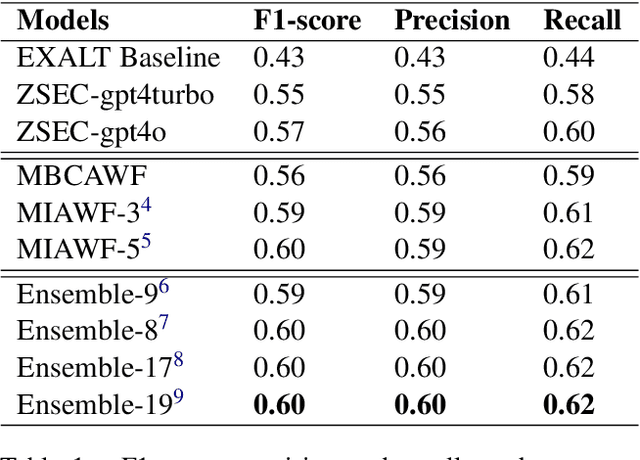
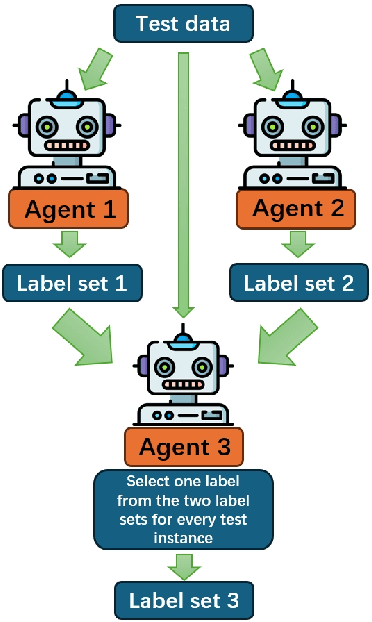
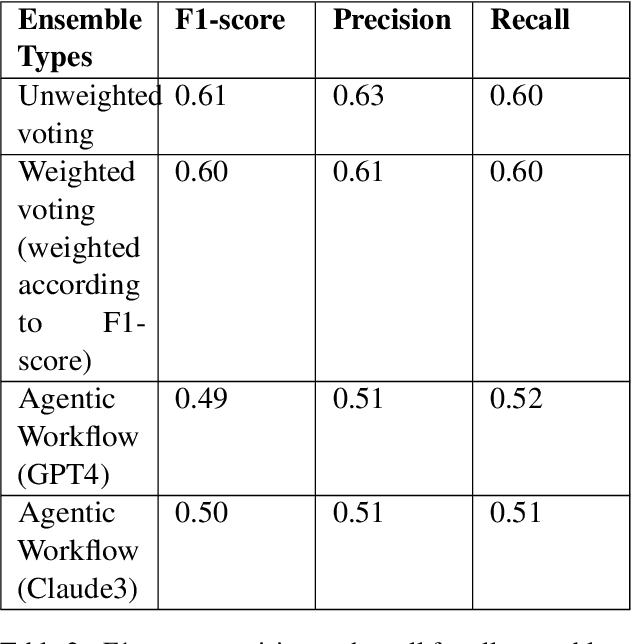
Abstract:Cross-lingual emotion detection allows us to analyze global trends, public opinion, and social phenomena at scale. We participated in the Explainability of Cross-lingual Emotion Detection (EXALT) shared task, achieving an F1-score of 0.6046 on the evaluation set for the emotion detection sub-task. Our system outperformed the baseline by more than 0.16 F1-score absolute, and ranked second amongst competing systems. We conducted experiments using fine-tuning, zero-shot learning, and few-shot learning for Large Language Model (LLM)-based models as well as embedding-based BiLSTM and KNN for non-LLM-based techniques. Additionally, we introduced two novel methods: the Multi-Iteration Agentic Workflow and the Multi-Binary-Classifier Agentic Workflow. We found that LLM-based approaches provided good performance on multilingual emotion detection. Furthermore, ensembles combining all our experimented models yielded higher F1-scores than any single approach alone.
Single Image Unlearning: Efficient Machine Unlearning in Multimodal Large Language Models
May 21, 2024



Abstract:Machine unlearning empowers individuals with the `right to be forgotten' by removing their private or sensitive information encoded in machine learning models. However, it remains uncertain whether MU can be effectively applied to Multimodal Large Language Models (MLLMs), particularly in scenarios of forgetting the leaked visual data of concepts. To overcome the challenge, we propose an efficient method, Single Image Unlearning (SIU), to unlearn the visual recognition of a concept by fine-tuning a single associated image for few steps. SIU consists of two key aspects: (i) Constructing Multifaceted fine-tuning data. We introduce four targets, based on which we construct fine-tuning data for the concepts to be forgotten; (ii) Jointly training loss. To synchronously forget the visual recognition of concepts and preserve the utility of MLLMs, we fine-tune MLLMs through a novel Dual Masked KL-divergence Loss combined with Cross Entropy loss. Alongside our method, we establish MMUBench, a new benchmark for MU in MLLMs and introduce a collection of metrics for its evaluation. Experimental results on MMUBench show that SIU completely surpasses the performance of existing methods. Furthermore, we surprisingly find that SIU can avoid invasive membership inference attacks and jailbreak attacks. To the best of our knowledge, we are the first to explore MU in MLLMs. We will release the code and benchmark in the near future.
Benchmarking Large Language Models in Complex Question Answering Attribution using Knowledge Graphs
Jan 26, 2024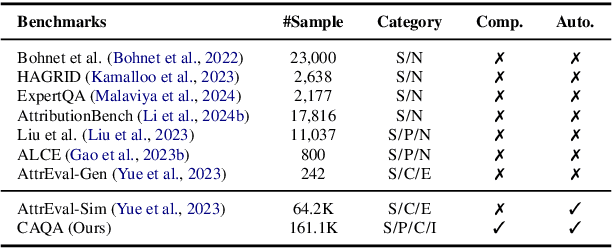

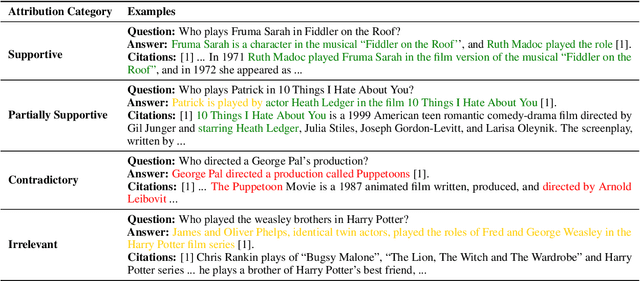
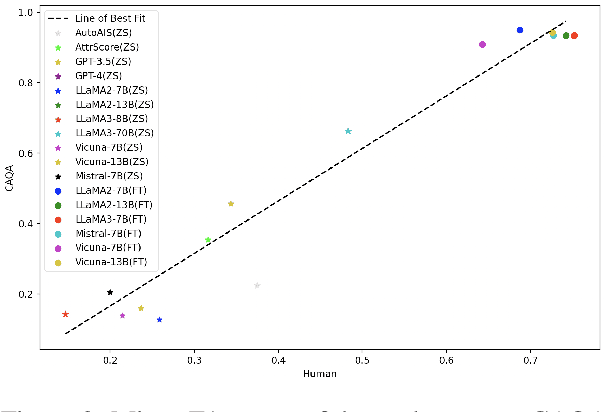
Abstract:The attribution of question answering is to provide citations for supporting generated statements, and has attracted wide research attention. The current methods for automatically evaluating the attribution, which are often based on Large Language Models (LLMs), are still inadequate, particularly in recognizing subtle differences between attributions, and complex relationships between citations and statements. To compare these attribution evaluation methods and develop new ones, we introduce a set of fine-grained categories (i.e., supportive, insufficient, contradictory and irrelevant) for measuring the attribution, and develop a Complex Attributed Question Answering (CAQA) benchmark by leveraging knowledge graphs (KGs) for automatically generating attributions of different categories to question-answer pairs. Our analysis reveals that existing evaluators perform poorly under fine-grained attribution settings and exhibit weaknesses in complex citation-statement reasoning. Our CAQA benchmark, validated with human annotations, emerges as a promising tool for selecting and developing LLM attribution evaluators.
Retrieve-Rewrite-Answer: A KG-to-Text Enhanced LLMs Framework for Knowledge Graph Question Answering
Sep 21, 2023Abstract:Despite their competitive performance on knowledge-intensive tasks, large language models (LLMs) still have limitations in memorizing all world knowledge especially long tail knowledge. In this paper, we study the KG-augmented language model approach for solving the knowledge graph question answering (KGQA) task that requires rich world knowledge. Existing work has shown that retrieving KG knowledge to enhance LLMs prompting can significantly improve LLMs performance in KGQA. However, their approaches lack a well-formed verbalization of KG knowledge, i.e., they ignore the gap between KG representations and textual representations. To this end, we propose an answer-sensitive KG-to-Text approach that can transform KG knowledge into well-textualized statements most informative for KGQA. Based on this approach, we propose a KG-to-Text enhanced LLMs framework for solving the KGQA task. Experiments on several KGQA benchmarks show that the proposed KG-to-Text augmented LLMs approach outperforms previous KG-augmented LLMs approaches regarding answer accuracy and usefulness of knowledge statements.
Robot Task Planning Based on Large Language Model Representing Knowledge with Directed Graph Structures
Jun 08, 2023


Abstract:Traditional robot task planning methods face challenges when dealing with highly unstructured environments and complex tasks. We propose a task planning method that combines human expertise with an LLM and have designed an LLM prompt template, Think_Net_Prompt, with stronger expressive power to represent structured professional knowledge. We further propose a method to progressively decompose tasks and generate a task tree to reduce the planning volume for each task, and we have designed a strategy to decouple robot task planning. By dividing different planning entities and separating the task from the actual machine binding process, the task planning process becomes more flexible. Research results show that our method performs well in handling specified code formats, understanding the relationship between tasks and subtasks, and extracting parameters from text descriptions. However, there are also problems such as limited complexity of task logic handling, ambiguity in the quantity of parts and the precise location of assembly. Improving the precision of task description and cognitive structure can bring certain improvements. https://github.com/NOMIzy/Think_Net_Prompt
 Add to Chrome
Add to Chrome Add to Firefox
Add to Firefox Add to Edge
Add to Edge